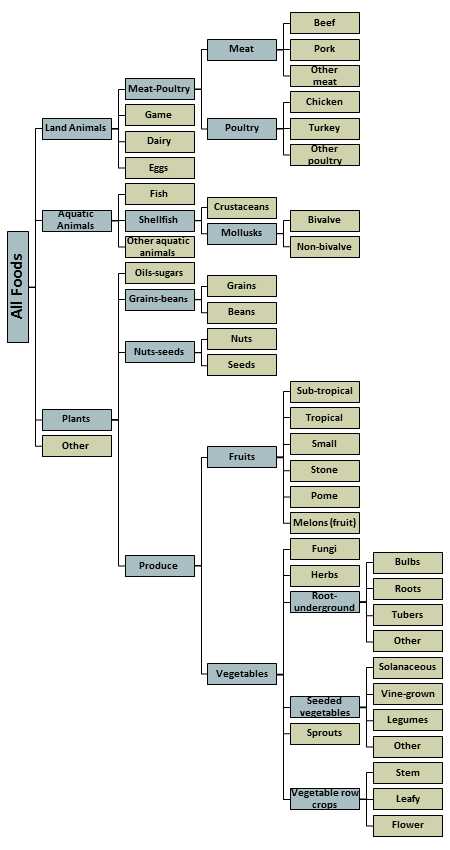Food Categorization Scheme (40 food sub-categories appear in tan cells)

This flowchart, produced by the Interagency Food Safety Analytics Collaboration (a tri-agency that includes CDC, FDA, and USDA-FSIS) is titled Food Categories with Examples. Not all food examples shown in this chart have been linked to outbreaks, and many foods not shown have been linked to outbreaks. This categorization scheme updates a former scheme to include more specific information.
This scheme has four main categories. The first is Land Animals and includes three sub-categories, Dairy, Eggs, and Meat-Poultry. Examples in Dairy include milk and hard and soft cheeses. Examples in Eggs include whole shell eggs, and egg whites in cartons. Meat-Poultry is divided into three sub-categories, Meat, Poultry, and Game. Meat is further divided into Beef, with ground beef and steaks as examples, Pork, with bacon and hams as examples, and Other Meat, with lambs and goats as examples. The Poultry sub-category is further divided into Chicken, with whole chickens and chicken deli meats as examples, Turkey, with turkey hot dogs and whole turkeys as examples, and Other Poultry, with ducks and ostriches as examples. The Game sub-category includes wild boars and venison as examples.
The second main category is Aquatic Animals and includes three sub-categories, Fish, Shellfish, and Other Aquatic Animals. Examples in the Fish sub-category include grouper and tuna. The Shellfish sub-category is further divided into Crustaceans, with crabs and lobster as examples. The Mollusks sub-category is further divided into Bivalve Mollusks, with clams and oysters as examples, and Non-bivalve Mollusks, with octopuses and squid as examples. The sub-category, Other Aquatic Animals, includes frogs and jellyfish as examples.
The third main category is Plants and includes four sub-categories, Oils-Sugars, Produce, Grains-Beans, and Nuts-Seeds. Examples in Oils-Sugars include olive oils, canola oils, sugars, and honey. Produce is divided into Vegetables and Fruits. The sub-category Vegetables is further divided into Fungi, Sprouts, Root-underground vegetables, Seeded vegetables, Herbs, and Vegetable row crops. Examples in Fungi include portabellas and button mushrooms. Examples in Sprouts include alfalfa sprouts and mung bean sprouts. The sub-category, Root-underground vegetables, is further divided into Roots, with examples carrots and beets; Tubers, with examples potatoes and yams; Bulbs, with examples garlic and onions; and Other, with examples ginger and taro.
The sub-category, Seeded vegetables, includes Vine-grown, with examples squashes and cucumbers; Solanaceous, with examples tomatoes and peppers; Legumes, with examples lima beans and snow peas; and Other, with examples okras and sweet corns. Examples in the sub-category Herbs include basil and cilantro. Vegetable row crops is further divided into Flowers, with examples artichokes and broccoli; Stems, with examples asparagus and celeries; and Leafy vegetable row crops, with examples lettuce and spinach. The sub-category, Fruits, is further divided into Melons, with examples cantaloupes and watermelons; Pomes, with examples apples and pears; Stones, with examples apricots and cherries; Small, with examples blueberries and strawberries; Tropical, with examples bananas and mangoes; and Sub-tropical, with examples avocadoes and oranges. The sub-category, Grains-Beans, is further divided into Grains, with examples rice and wheat; and, Beans, with examples pinto beans and black beans. The sub-category, Nuts-Seeds, is further divided into Nuts, with examples peanuts and almonds; and, Seeds, with examples sesame seeds and pumpkin seeds.
The final category, Other, includes examples ice and dietary supplements.
This chart is based on work of the Interagency Food Safety Analytics Collaboration, a partnership between the Centers for Disease Control and Prevention, the United States Food and Drug Administration, and the United States Department of Agriculture’s Food Safety and Inspection Service.
Read about the previously-used food categorization scheme in Recipes for foodborne outbreaks: a scheme for categorizing and grouping implicated foods in Foodborne Pathogen Diseases, 2009, Volume 6, pages 1259-64.
For more information, visit the Food Safety Interagency Food Safety Analytics Collaboration (IFSAC) web site.
- Page last reviewed: February 24, 2015
- Page last updated: February 24, 2015
- Content source:


 ShareCompartir
ShareCompartir